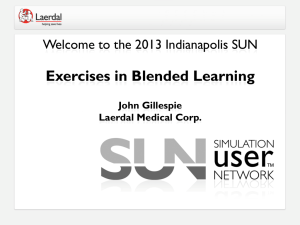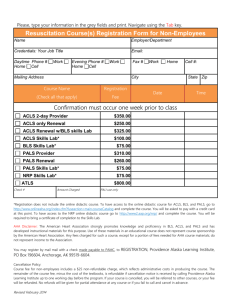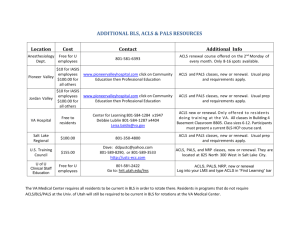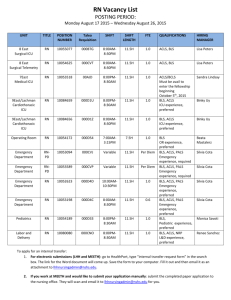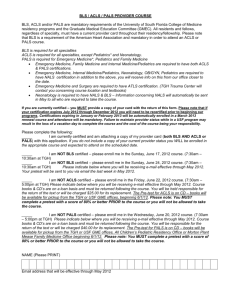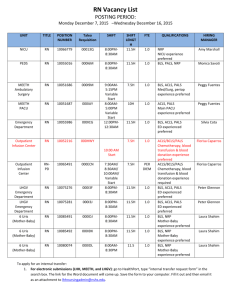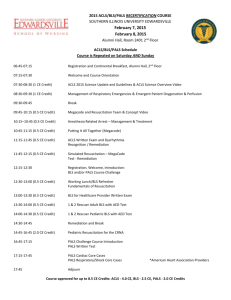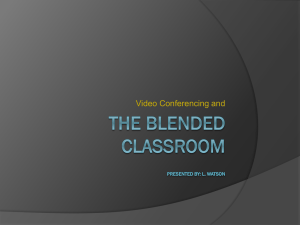Utilizing Blended Learning to Improve Efficiencies | Donna
advertisement
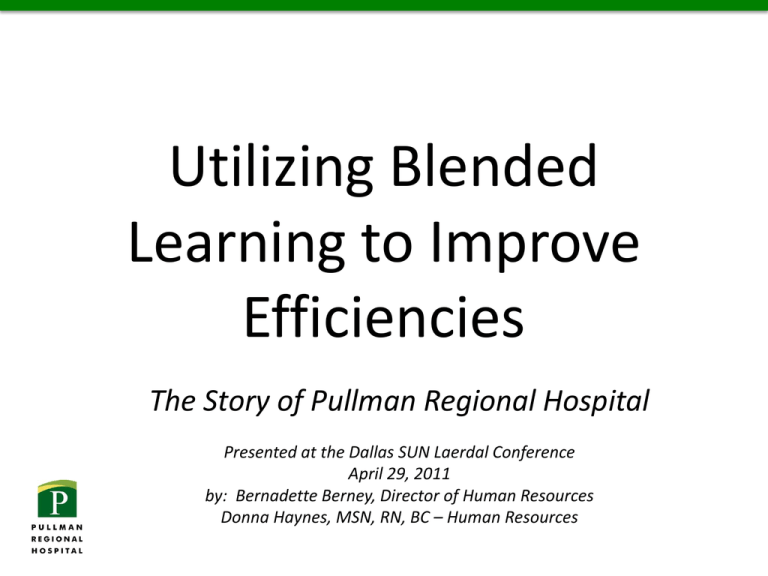
Utilizing Blended Learning to Improve Efficiencies The Story of Pullman Regional Hospital Presented at the Dallas SUN Laerdal Conference April 29, 2011 by: Bernadette Berney, Director of Human Resources Donna Haynes, MSN, RN, BC – Human Resources Objectives At the end of this session, learners will be able to: • Understand the alignment of blended learning with organizational cultural traits. • Identify decision components for blended learning solutions. • Review key elements of adult learners. • Discuss attributes that contribute to highly efficient and highly effective blended learning programs. • List the outcomes from effective resuscitation training programs. Pullman Regional Hospital • • • • • • • Located in Pullman, Washington New Hospital December 2004 25-Bed Critical Access Hospital 400 Employees 60 Medical Staff Providers Home of Washington State University Agricultural Region – Dry Land Farming Pullman Regional Hospital • 2007 – 2010 Most Wired Small and Rural Hospitals – Hospital and Health Network • 2009 Summit Award Recipient – Press Ganey • #1 in Overall Patients Satisfaction in Washington State – HCAHPS April 2009 to March 2010 • Affiliate clinical site for students Organizational Cultural Traits • Personal Accountability – employees are accountable for obtaining and maintaining their required certifications. • Choice – employees are given a choice as to how they would like to attain their certifications. • Serving Others – a high level of customer service is provided to the users of the BLS, ACLS, and PALS systems. Organizational Cultural Traits • Flexibility – employees can do their learning either at the hospital or off-site. • Transparent – the completion of the modules is tracked on the HealthStream system. • Consistency – the instruction is the same for each employee who takes the certification – it is not instructor dependent. Organizational Cultural Traits • Personal Growth – employees have the opportunity to obtain certifications that are and are not required for their positions. • Inclusive – any employee of the hospital can take a certification course including employees in non-clinical roles. • Progressive – the hospital provides the opportunity to obtain certifications using blended learning. Organizational Practices • Staffing levels – by design – most areas of the hospital have staffing levels that are above average. • No Mandatory Low Census – the hospital does not low census any staff during periods of low patient volume. • Mandatory is a “four letter” word – it is not a part of our organizational culture. Audience Infrastructure Context Decision Components for Blended Learning Solutions Organization Outcomes Audience • What do we know about the learners? Organization • Is the organization ready and supportive of blended options? Context • What issues unique to this context should be considered? Infrastructure • Are there any barriers to the technologybased delivery? Outcomes • What do the learners need to be able to do? The Adult Learner • Is autonomous and self-directed • Has accumulated a foundation of experiences and knowledge • Is goal-oriented • Is relevancy oriented • Is practical • Needs to be shown respect Consider Components of Best Practices in Implementing Simulation Education • Contextual Learning (Kneebone) • Mastery Learning (Bloom) • Deliberate Practice (Ericcson) Our Approach • Partnered with HealthStream and Laerdal • Embraced an “anytime-anywhere” approach • Knowledgeable of the programs and manikins • Committed to a high level of customerservice HealthStream-Laerdal-AHA • BLS • ACLS • PALS Anytime-Anywhere • IT Solutions • Access outside of the organization • Availability of the Skills Lab IT Solutions • Updated the Adobe Flash Players • Gave software download administrative rights to targeted computers for PALS • Provide a high level of customer service to assist the staff with individual computer challenges Access Outside the Organization Availability of the Skills Lab • 24/7 access • Priority for use Knowledge of Programs and Manikins • Know what makes the manikins thrive • Pearls that reinforce proper technique • What constitutes a repeat of the simulation • Know where the resources are in the programs What Makes This Approach Efficient and Effective? • • • • Certification Tracking Staff satisfaction scores Decreased organizational costs Increased confidence in competence Certification Tracking • • • • • Use payroll system tracks certification dates. Staff call and ask for courses to be loaded. HLC Administrator reviews expiration date. BLS automatically loads every 2 years. Certification tracked through annual performance reviews. Staff Satisfaction Scores • BLS – 227 total employees – Overall content of program – 90% appropriate/very appropriate – How likely are to you recommend this program to your colleagues? – 64% somewhat likely/very likely • ACLS – 63 total employees – Overall content of program – 65% appropriate/very appropriate – How likely are to you recommend this program to your colleagues? – 56% somewhat likely/very likely Staff Satisfaction Scores • PALS – 13 total employees – Overall content of program – 85% appropriate/very appropriate – How likely are to you recommend this program to your colleagues? – 77% somewhat likely/very likely Staff Comments - Positive • “Learning is easy at my own pace and review is also easy.” • “I was pleased with the learning styles utilized within this program.” Staff Comments - Positive • “I liked doing this on the computer. It gave me time to think without pressure.” • “I prefer self-directed study over classroom teaching. I can learn at my own pace and focus on the areas I need more knowledge.” Staff Comments – Challenges • “I prefer a class setting with instructors so that when I have questions, I have someone present to answer them.” • “I am not very good at using computer simulated tools and would prefer a live class by far.” Staff Comments – Challenges • “More time is spent trying to locate appropriate actions/interventions in the program then actually reviewing or learning from it.” • “I am little disappointed that I could not download or print the educational materials. I think they should come with the course either hard copy or the option to save them on a zip drive.” Decrease Organizational Costs • Estimated Average Savings per Employee – BLS $117.00 per employee – ACLS $1,062.00 per employee • Estimated Average Savings Total – BLS $26,559.00 for 227 employee – ACLS $66,906.00 for 63 employee • Total Estimated Savings $93,465.00* over 3 + yrs *salary expense is using 2011 wages Increased Confidence in Competence • C.N.A. Story • Nursing students • First-time takers • “Can’t pass unless you do it right” Putting it All Together • Blended learning should include the opportunities to: –Reflect –Apply –Build Team Putting it All Together • Mock Codes • Monthly Skill Focus • Continuing Education QUESTIONS? References • Bloom, B. (1987). The Mastery of Learning: notes from a Benjamin Bloom lecture. Retrieved April 2, 2011 from: http://learn.midsouthcc.edu/learningObjects/masteryLearning/prin tout.pdf • Kneebone, R (2005). Evaluating clinical simulations for learning procedural skills: A theory based approach. Academic Medicine, 80, 6, 549-553. • Kolb, D. (2009). David Kolb on experiential learning. Retrieved April 2, 2011 from: http://www.infed.org/biblio/b-explrn.htm • Merrill, M.D. (1994). Instructional design theory. Englewood Cliffs, N.J.: Educational Technology Publications.

